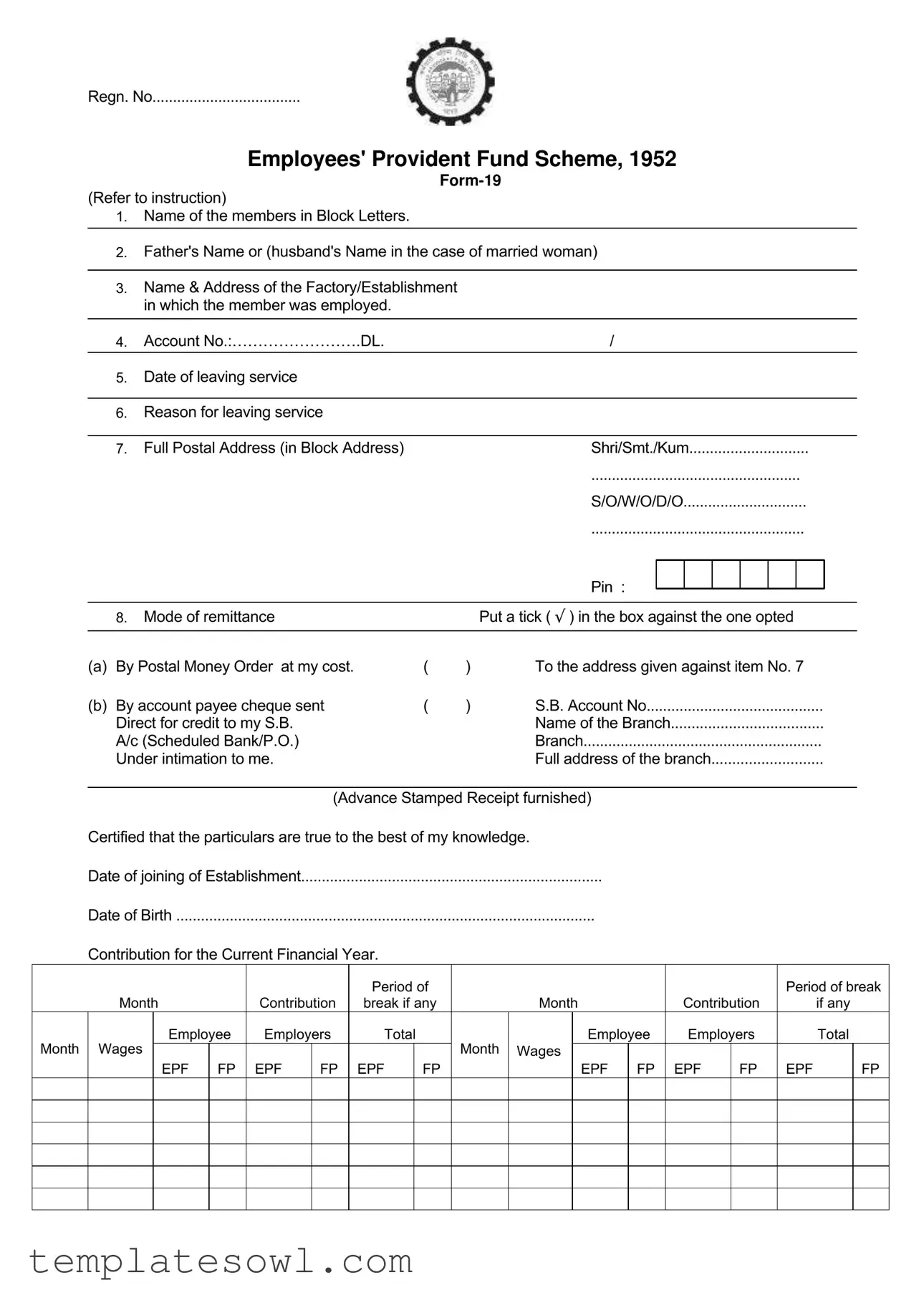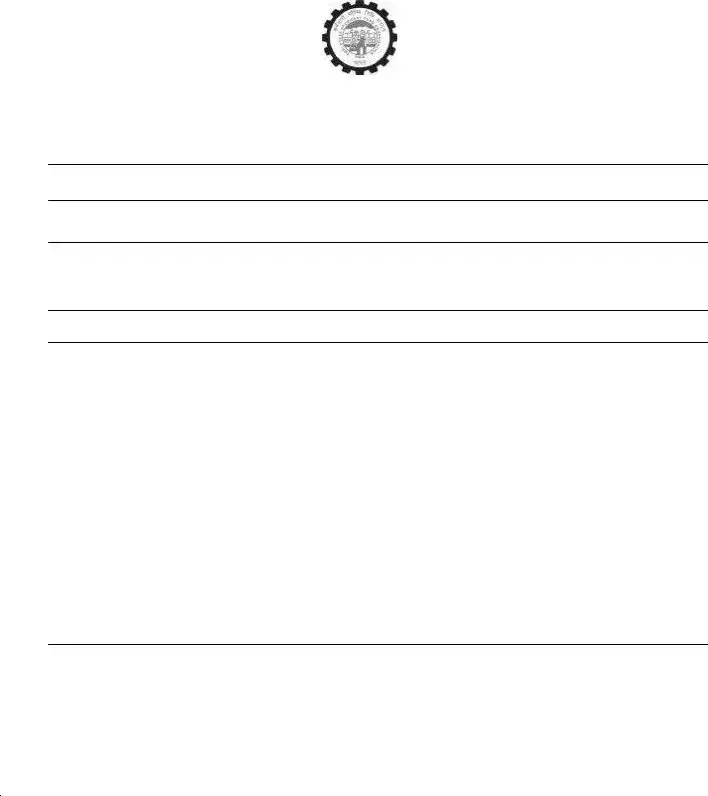Regn. No....................................
Employees' Provident Fund Scheme, 1952
Form-19
(Refer to instruction)
1.Name of the members in Block Letters.
2.Father's Name or (husband's Name in the case of married woman)
3.Name & Address of the Factory/Establishment in which the member was employed.
4. Account No.:…………………….DL. |
/ |
5.Date of leaving service
6.Reason for leaving service
7. |
Full Postal Address (in Block Address) |
Shri/Smt./Kum |
|
|
................................................... |
|
|
|
S/O/W/O/D/O |
|
|
.................................................... |
|
|
|
Pin : |
|
|
|
|
|
|
|
|
|
|
|
|
|
|
|
|
|
|
|
|
|
|
|
|
|
|
|
|
|
8. |
Mode of remittance |
Put a tick ( Ö ) in the box against the one opted |
|
|
|
|
|
|
|
|
|
|
|
(a)By Postal Money Order at my cost.
(b)By account payee cheque sent Direct for credit to my S.B. A/c (Scheduled Bank/P.O.) Under intimation to me.
( |
) |
To the address given against item No. 7 |
( |
) |
S.B. Account No |
|
|
Name of the Branch |
|
|
Branch |
|
|
Full address of the branch |
(Advance Stamped Receipt furnished)
Certified that the particulars are true to the best of my knowledge.
Date of joining of Establishment.........................................................................
Date of Birth ......................................................................................................
Contribution for the Current Financial Year.
|
|
|
|
|
|
Period of |
|
|
|
|
|
|
Period of break |
|
Month |
|
Contribution |
break if any |
|
Month |
|
Contribution |
|
if any |
|
|
Employee |
Employers |
Total |
|
|
|
Employee |
Employers |
|
Total |
Month |
Wages |
|
|
|
|
|
|
|
Month |
Wages |
|
|
|
|
|
|
|
|
|
EPF |
FP |
EPF |
FP |
EPF |
|
FP |
|
|
EPF |
FP |
EPF |
FP |
EPF |
|
FP |
|
|
|
|
|
|
|
|
|
|
|
|
|
|
|
|
|
|
|
|
|
|
|
|
|
|
|
|
|
|
|
|
|
|
|
|
|
|
|
|
|
|
|
|
|
|
|
|
|
|
|
|
|
|
|
|
|
|
|
|
|
|
|
|
|
|
|
|
|
|
|
|
|
|
|
|
|
|
|
|
|
|
|
|
|
|
|
|
|
|
|
|
|
|
|
|
|
|
|
|
|
|
|
|
|
|
|
|

( information to be furnished by the Employer if the Claim Form is Attested by the Employer)
Certified that the above contributions have been included in the regular monthly remittances.
The Applicant has signed/Thumb impressed before me.
............ .....................................................
Signature of Left/Right hand thumb impression of the member
Date......................................
Designation & Seal
Encl.
Declaration of non-employment
Note:- In the case of submission of application for settlement under clause (s) of sub-paragraph (i) and in clause (b) of sub-paragraph (2) of paragraph 69 of the EPF Scheme, 1952, the claim should be submitted after two months from the date of leaving service provided the member continues to remain unemployed in an establishment to which the Act applies.
Date |
Signature or Left / Right hand thumb impression of the member |
|
|
ADVANCE STAMPED RECEIPT (To be furnished only in case of 8 (b) above)
Received a sum of Rs. ....................(Rupees .......................................................... .......................... from
Regional Provident Fund Commissioner / Officer-in-Charge of Sub-Accounts Office ..........................................
by deposit in my Savings Bank account towards the settlement of my Provident Fund Account.
The space should be left blank which shall be filled in by Regional Provident Fund Commissioner/Officer in-Charge of S.A.O.
Affix 1/- Rupee
Revenue
Stamp
Signature orLeft / Right hand thumb impression of the member
(For the use of Commissioner's Office)
A/C Settled in part/Full Entered in F. 21-A/24/219 & withdrawal register.
|
Clerk |
Section Supervisor |
P.I.No.------------------------------------------------------------------------- |
M.O./Cheque ---------------------------------- |
Account No. ----------------------------- |
Section |
------------------------ passed for payment for Rs.------------------- |
¼in words)-------------------------------------------------------------------------------------------------------------------------------
M.O. Commission (if any) AOC/APFC-----------------------------------
Net Amount to be paid by M.0……………………………Date………………..
|
(For use in Cash Section) |
|
Paid by inclusion in Cheque No |
............................ |
date |
vide Cash Book (Bank) Account No.3 Debit Item No |
HC |
|
AC / RC |
|
|
|
|
Remarks |
|


